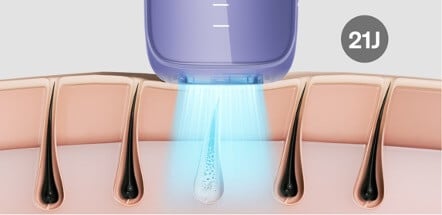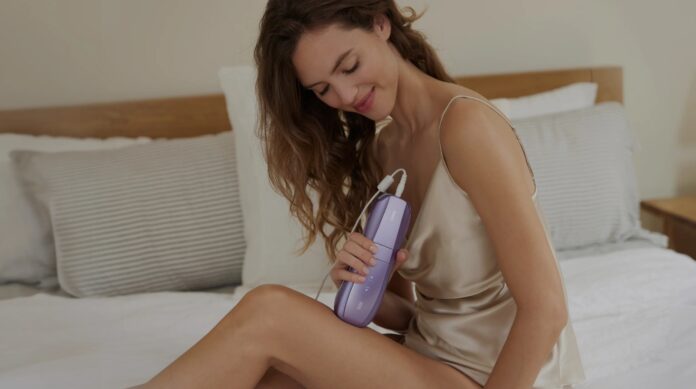This article will explore how pregnancy can impact the hair cycle on the body and how the IPL hair removal method works, to understand if it’s safe to use IPL during pregnancy and breastfeeding, or whether it’s better to avoid it and why.
How does the skin change during pregnancy? (A focus on the hair cycle)
Pregnancy is a period in which more than 90% of women can experience important skin changes that may have a great impact on their lives [1]. For instance, women experience many physiologic variations during pregnancy that might lead to the development or worsening of acne vulgaris and an increase in hair growth on various parts of the body [2], as well as other skin problems such as pregnant-related dermatoses and hyperpigmentation [1], striae and varicose veins [3].
Pregnancy and the hair
The growth of hair is a cyclical process. The cycle consists of stages of rapid growth and elongation of the hair shaft, which alternates with periods of rest and regression driven by apoptotic (aka programmed cell death) signals [4]. This cycle can be divided into three phases [4]:
- Anagen (growth): This is the active phase in which the hair follicle works to produce the hair fiber.
- Catagen (transition): This phase begins with the end of the anagen phase and is characterized by a transition into the resting phase. During this phase, the hair follicle undergoes a regression and loses about one-sixth of its standard diameter.
- Telogen (rest): This is the resting phase of the hair cycle in which the hair follicle is inactive, and growth of the hair shaft does not occur anymore. It is followed by detachment and falling out of the hair.
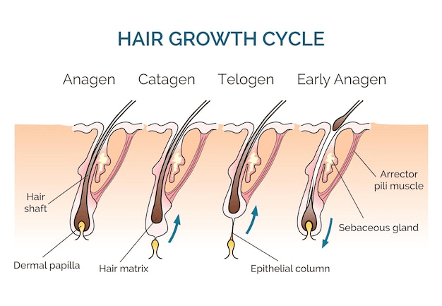
During pregnancy, a mild to moderate increase in hair growth can occur due to hormonal changes. For instance, the stimulation of estrogen and androgen in the second half of pregnancy [1] might increase the number of hair follicles that remain in the anagen phase (growth) [5], meaning that the hair keeps growing.
After delivery, this hormone-induced hair growth usually resolves, and hair follicles return to the telogen phase (resting) within 3–6 months of delivery with a sudden drop in hormone levels. This results in excessive shedding of hair known as post-partum telogen effluvium [5].
What does it mean? It means that during pregnancy the number of shedding hair is reduced, and they not only keep growing in the hair follicles, but they can also increase their diameter (grow thicker), leading to a hormone-induced presence of new terminal hair growth in different body parts such as at the abdomen, the lower back, and the thighs [6], which may become of main concern for women during pregnancy, seeking hair removal methods to help manage this cosmetic concern.
If you are an IPL user, at this point you may be wondering if you can keep using your IPL device during pregnancy to remove all the new hair that is expected to be present during this period. Let’s dive into it, shall we?
What is IPL and how does it work?
 To understand the safety issues that could be associated with IPL use during pregnancy, let’s start by describing the IPL hair removal method and how it works.
To understand the safety issues that could be associated with IPL use during pregnancy, let’s start by describing the IPL hair removal method and how it works.
IPL stands for Intense Pulsed Light . It’s a popular hair removal method consisting of a device suitable for home use, which can permanently reduce the growth of hair in several parts of the body, including larger surface areas, such as the back, belly, and legs due to its large spot size [7]. To achieve permanent hair reduction, several treatment sessions are required.
How does it work? IPL consists of high-intensity light sources that make use of a high-output flashlamp that produces a broad wavelength output of noncoherent light, normally in the range of 500 to 1200 nm [7]. Its hair removal ability is based on the principle of selective photothermolysis , targeting melanin (which is the pigment that gives color to the hair) at the hair bulb to cause the relatively selective thermal destruction of the hair follicles at suitable wavelengths [8].
Individual light pulses have a specific duration, intensity, and spectral distribution allowing for a controlled and confined energy delivery into the hair follicle [7].
The advantages? IPL offers the possibility to perform the treatment with home-use devices , which are reported to be as successful as laser systems because of the same thermal effect. It’s of a lower cost and larger spot size facilitating more rapid treatment [9].
The disadvantages? Treatment is more effective in those with lighter complexions and darker hair and is therefore considered ineffective or unsafe in those with darker complexions or lighter hair. Side effects such as pain, erythema, swelling, and pigmentation have been reported [10], but they tend to be infrequent and transient, being a safe method when used correctly [8].
Indeed, to avoid potential side effects, some modern IPL devices are designed with cooling systems to protect the skin. For instance, Ulike Sapphire Air 3 IPL devices adopt the Sapphire Ice-Cooling patent technology to offer a pain-free treatment.
Is it safe to use an IPL hair removal device during pregnancy?
As mentioned, IPL for hair removal acts on the very principle of selective photothermolysis, meaning that in theory, its action will selectively remain on the hair structures being targeted on the skin, preventing it from going beyond the deep dermis, thereby precluding any harm to the fetus [3]. However, due to the unavailability of safety studies on this matter, IPL should be avoided during pregnancy [3].
For instance, a review of the safety of different cosmetic procedures during pregnancy and lactation, published in the International Journal of Women’s Dermatology in 2017 [11] stated that IPL and laser therapies are not indicated for cosmetic procedures (such as hair removal) during pregnancy due to the lack of safety data , recommending pregnant women to treat excess hair growth only with temporary hair removal methods (such as waxing and shaving).
So, can you use IPL during pregnancy?
The answer is no , you should not use IPL as a hair removal method to get rid of hair during pregnancy for the safety of both you and the baby.
Moreover, aside from the safety component, it is expected that due to all the hormonal changes produced during pregnancy, the continued stimulation of new hair growth could lead to unsatisfactory treatment responses with IPL [3], being less likely to work.
Hormonal and physiological changes in the body may also make the skin and hair more sensitive and vulnerable to damage during pregnancy. Therefore, it is recommended that pregnant women avoid using IPL hair removal devices also for these reasons.
What can you do then? Safe alternatives for hair removal during pregnancy.
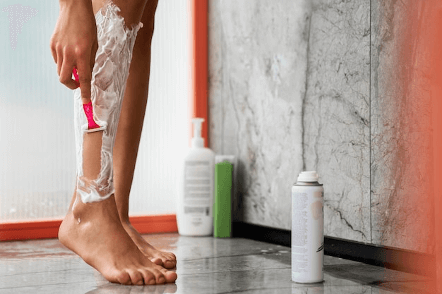
Since excess body hair growth may resolve postpartum, temporary epilation treatments are the safest hair removal methods recommended during pregnancy [11]. Shaving and waxing are recommended, which can be followed by the application of moisturizing creams or lotions to reduce any skin damage that may be caused by these techniques.
Is using an IPL hair removal device safe during breastfeeding?
After delivery, you may be wondering if it’s already the right time to start using IPL again. Unfortunately, the answer is still no. IPL is also contraindicated in breastfeeding women [12].
Although there is no detailed research on the safety of using IPL hair removal devices during breastfeeding, it is recommended to avoid using them for safety reasons. If you have any concerns, we advise you to please consult your doctor on this matter for better guidance.
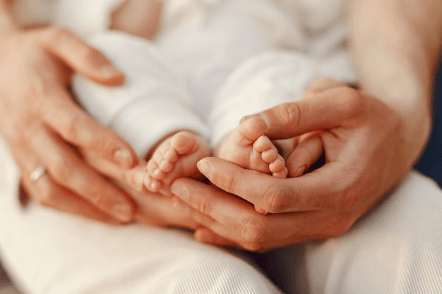
IPL hair removal after giving birth: how long do you have to wait?
After all the physiological changes your body went through during pregnancy, it may need time to fully recover and stabilize its hormonal levels and skin sensitivity. Therefore, we recommend that mothers wait at least 6 months after giving birth or after weaning before considering using an IPL hair removal device.
As we mentioned before, after delivery it’s expected that the hormone-induced hair growth resolves on its own within 3–6 months postpartum, following the sudden drop in hormone levels [5].
THE TAKEAWAY
During pregnancy, your body goes through several physiological and hormonal changes to support the healthy development of your baby. Such changes may impact your skin in different ways, including a sudden increase in hair growth that you may want to get rid of. For this, it’s advised that for safety reasons you avoid using IPL hair removal devices during pregnancy and breastfeeding, opting for safer choices such as shaving and waxing.
REFERENCES
[1] Vora, R. V., Gupta, R., Mehta, M. J., Chaudhari, A., Pilani, A. P., & Patel, N. (2014). Pregnancy and skin. Journal of Family Medicine and Primary Care, 3(4), 318–324. https://doi.org/10.4103/2249-4863.148099
[2] Bozzo, P. (2011, June 1). Safety of skin care products during pregnancy. PubMed Central (PMC). https://www.ncbi.nlm.nih.gov/pmc/articles/PMC3114665/
[3] Mysore, V., & Garg, A. (2022). Dermatologic and cosmetic procedures in pregnancy. Journal of Cutaneous and Aesthetic Surgery, 15 (2), 108. https://doi.org/10.4103/jcas.jcas_226_20
[4] Hoover, E. (2022, July 25). Physiology, Hair. StatPearls – NCBI Bookshelf. https://www.ncbi.nlm.nih.gov/books/NBK499948/
[5] Gizlenti, S., & Ekmekci, T. R. (2014). The changes in the hair cycle during gestation and the post-partum period. Journal of the European Academy of Dermatology and Venereology, 28 (7), 878–881. https://doi.org/10.1111/jdv.12188
[6] Grymowicz, M., Rudnicka, E., Podfigurna, A., Napierała, P., Smolarczyk, R., Smolarczyk, K., & Meczekalski, B. (2020). Hormonal Effects on Hair Follicles. International Journal of Molecular Sciences, 21 (15), 5342. https://doi.org/10.3390/ijms21155342
[7] Goldberg, D. J. (2012, June 1). Current Trends in Intense Pulsed Light. PubMed Central (PMC). https://www.ncbi.nlm.nih.gov/pmc/articles/PMC3390232/
[8] Thacker, P. M., & Kumar, P. (2016). Near infrared pulsed light for permanent hair reduction in Fitzpatrick skin types IV and V. Journal of Cutaneous and Aesthetic Surgery, 9 (4), 249. https://doi.org/10.4103/0974-2077.197078
[9] Karaca, Ş., Kaçar, S. D., & Ozuğuz, P. (2012). Comparison of SHR Mode IPL System with Alexandrite and Nd: YAG Lasers For Leg Hair Reduction. Balkan Medical Journal, 29 (4), 401–405. https://doi.org/10.5152/balkanmedj.2012.033
[10] Somani, N., & Turvy, D. N. (2014). Hirsutism: An Evidence-Based Treatment Update. American Journal of Clinical Dermatology, 15 (3), 247–266. https://doi.org/10.1007/s40257-014-0078-4
[11] Trivedi, M., Kroumpouzos, G., & Murase, J. E. (2017). A review of the safety of cosmetic procedures during pregnancy and lactation. International Journal of Women’s Dermatology, 3 (1), 6–10. https://doi.org/10.1016/j.ijwd.2017.01.005
[12] Gade, A. (2023, January 2). Intense Pulsed Light (IPL) Therapy. StatPearls – NCBI Bookshelf. https://www.ncbi.nlm.nih.gov/books/NBK580525/

 By Gabriela Bermudez, MSc
By Gabriela Bermudez, MSc
 April 21, 2023
April 21, 2023
 7 minutes
7 minutes









